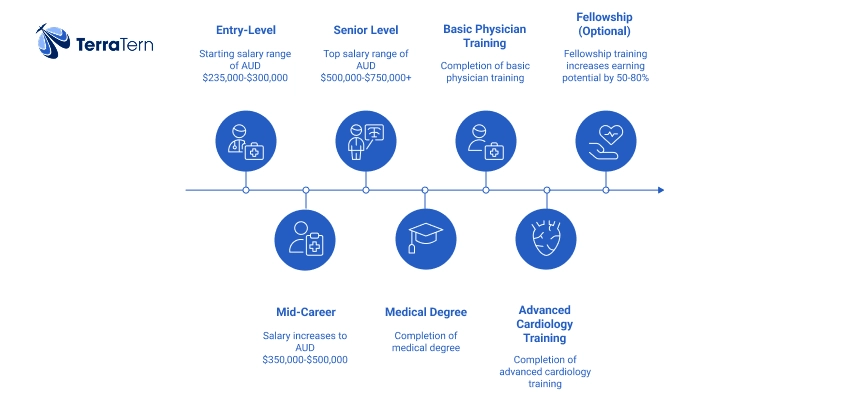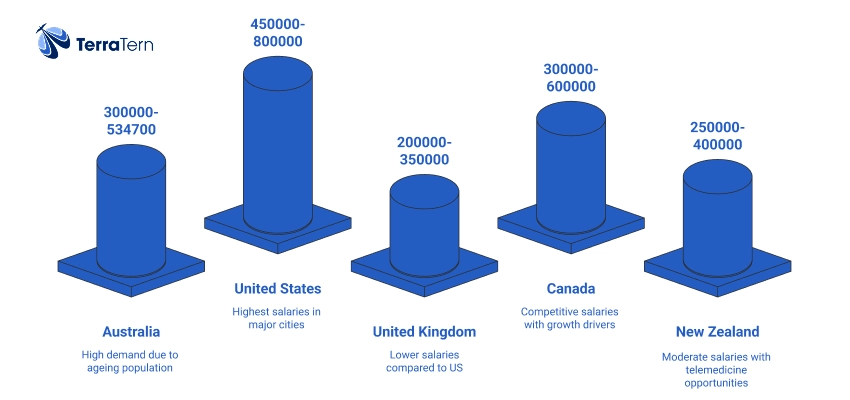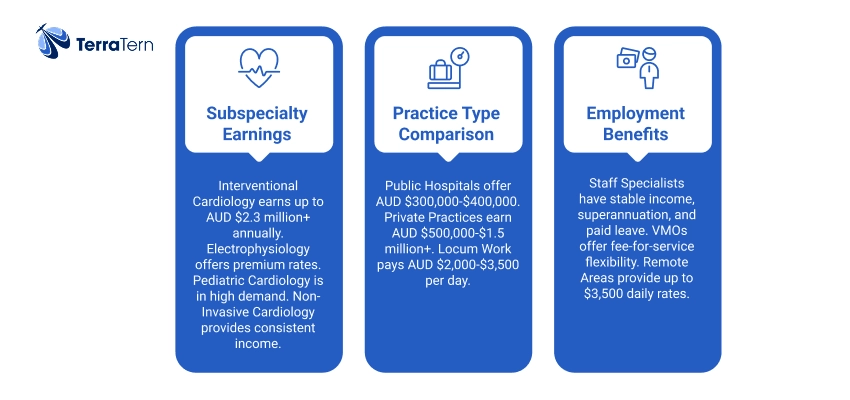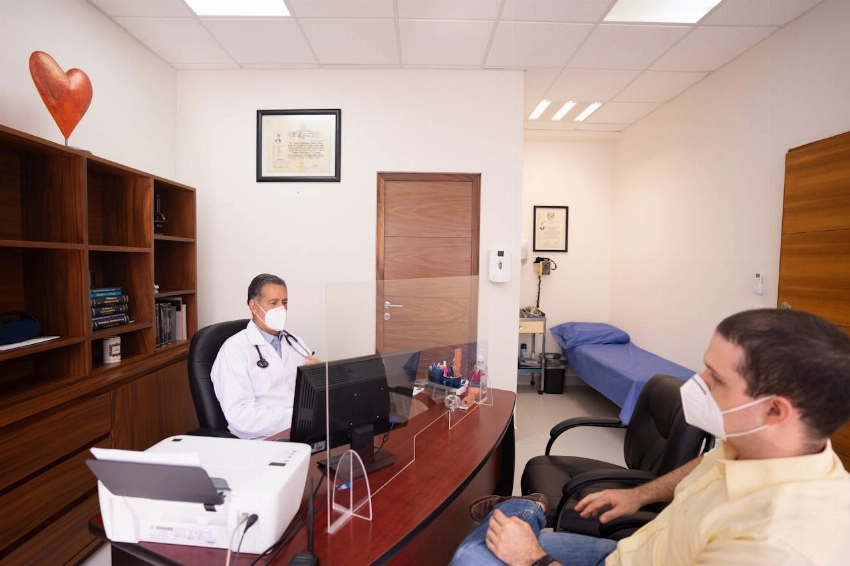Key Highlights
- Cardiologist Salary Australia for Indians in 2025: Complete Breakdown
- What are the Current Factors Influencing Cardiologist Salaries in Australia in 2025?
- How to Maximize Your Salary of a Cardiologist in Australia in 2025?
- Cardiologist Career Path and Training Requirements for Australia in 2025
- Work-Life Balance and Job Satisfaction in 2025
- What are the Visa Requirements for Cardiologist in Australia in 2025?
- Latest Future Outlook for Cardiologist Salaries in Australia 2025
- Comparing Latest International Cardiologist Salaries With Australia in 2025
- Latest Facts & News
- Conclusion
In 2025, cardiologist salary Australia are among the most sought-after queries among doctors and future doctors. The need for cardiologists has never been higher, with the population growing daily and cardiovascular disease increasing multiple times. Salaries do not just sound alluring but also differ highly based on specialisation, geographical setting, and employment category.
Cardiologist Salary Australia for Indians in 2025: Complete Breakdown

The cardiologist salary Australia with an average salary of cardiologist is one of the highest within the medical industry, which is not only an implication of the importance of the work the speciality does in the diagnosis and treatment of heart diseases, but also the years spent in training and the experience the job demands. Numerous factors affect the years of clinical practice, select subspecialty, and practice type, which determine earnings. This is because earnings differ among years of clinical practice, selected subspecialty, and kind of practice (whether one practices in a government public hospital, private clinic, or becomes a locum).
The geographic location is also essential, as specialists in rural and remote areas are offered other incentives, better daily rates, and relocation packages to draw their expertise. Besides, to increase their revenue even more, cardiologists can take additional fellowships, subspecialty certifications, or a telemedicine occupation, enabling them to earn the great respect of people worldwide.
Cardiologist Average Salary Ranges by Experience Level in 2025

There is a considerable increase in cardiologist salary Australia with experience, showing the worth of previous experience, professional stature, and proficiency in performing the procedures.
-
Entry-Level Cardiologists: Usually receive AUD 235,000-300,000 immediately after finishing their advanced cardiology training. They develop fundamental experience, learn hospital systems, and gain clinical judgment during this level.
-
Mid-Career Cardiologists: Earn AUD 350,000-500,000, with 3-5 years of experience, advanced training, and a network. Many assume leadership roles, guide juniors, and even enter private practice at this step.
-
Experienced Cardiologists: Senior Command AUD$500,000-750,000+, have deep experience, advanced competence, and clinical or management leadership capacity. Senior experts tend to engage in private practice, complex procedures, education, or research, increasing their potential income.
This evolution clearly demonstrates how clinical experience, specialisation, and professional advances in a career can raise the cardiologist's salary in Australia over the years to a point that it could only be considered a dramatic change in payment.
Also Read: Freshers' Job in Australia for Indians: A Comprehensive Guide
Latest Public vs Private Sector Earnings as a Cardiologist in Australia
Cardiologist salary Australia can work either in a private practice or a public hospital system, and a cardiologist's salary in Australia varies significantly between these types because of the structure, autonomy, and patient burden variances.
-
Public Hospital Wages: The wages are usually AUD 300,000 -400,000 per year, and there is assured income, overall benefits, and a regulated workplace. Teaching and research opportunities and access to multidisciplinary teams are typical roles in public hospitals.
-
Salary in Private Practice: This can go as high as AUD 500,000 to 1,5 million + yearly, depending on patient numbers, complexity of procedures, and management. Private practice also has the advantages of more autonomy, scheduling flexibility, and opens the possibility of entrepreneurial expansion.
Although the earning potential of a private practice is high, it takes proper planning, start-up capital, business sensitivity, and skilful risk management to hold up over time and guarantee a profitable business.
Selecting the sector is an essential determinant of the general cardiologist's salary in Australia. It is based on career ambitions, living choices, and the desire to take on the burden of entrepreneurship as relatively new cardiologists.
What are the Current Factors Influencing Cardiologist Salaries in Australia in 2025?

A cardiologist salary Australia has many factors that impact the doctors' salaries, making it one of the most versatile and potentially rich medical career opportunities. The most important determinants are the subspeciality selected, the geographical location, and the mode of employment, which can cause significant disparities in the annual earnings. For example, the income threatens to surpass that of interventional cardiologists, such as angioplasty and stenting. It can also surpass the specialists in the non-invasive branch of cardiology, specialising in diagnostics and prevention.
Geographic location is also a crucial factor, as cardiologist salary Australia located in remote or regional locations are often provided with a higher base salary, locum incentives, and additional allowances to encourage them to work as well as stay in their locations. Similarly, the type of practice influences the earnings, where doctors in private practice are usually more highly compensated than their counterparts in government hospitals due to the larger patient load, remuneration of procedures, and chances of expansion of the office. These aspects, coupled together, make cardiology a competitive profession in Australia that is lucrative and shaped by strategic career moves.
Cardiologist Specialisation Impact on Earnings in 2025
Various cardiologist salary Australia subspecialties may contribute to the occurrence of notable cardiologist salaries in Australia due to the degree of expertise, pressure, and difficulty in each discipline.
-
Non-Invasive Cardiology: Provides consistent income and concentration on diagnosis and prevention, although usually less than in translational positions.
-
Interventional Cardiology: Pays the highest wages, usually more than AUD 2.3 million a year, as the procedures, such as angioplasties and the insertion of stents, are not only complex but high in demand as well.
-
Electrophysiology: Those among the specialists who deal with heart rhythm disorders have a significant income due to their enhanced skills in their technical faculties and niche knowledge.
-
Pediatric Cardiology: Careful of children and young patients and highly rewarding in terms of career satisfaction as well as in demand, with an average slightly lower payment than interventional cardiology.
Latest Geographic Salary Variations for Cardiologists in Australia

The significant factor impacting cardiologist salary Australia is geographic location because regions in the country and remote regions receive lower payment than urban areas.
-
Larger Cities (Sydney, Melbourne) - Dealing with larger numbers of patients and such demand for specialised care in cardiac services, yields high salaries and benefits.
-
Regional Locations- Hospitals or clinics may offer special incentives, such as relocation allowances or larger base salaries, to entice a cardiologist to work in a regional area.
-
Remote Areas- Bonuses and reasonable locum payment to specialists in remote areas are often high. They are usually between the brackets of AUD 2,500-$3,500 daily to account for the need and the difficulty of practising in the regions that are less accessible.
Also Read: New Requirements By the Australia Government On English Language Test For Visas
Current Employment Type and Benefits
Employment structure is one of the key determinants in setting the cardiologist salary Australia since the structure of employment gives or takes forms of stability, flexibility, and earning potential. Selecting a type of employment can be influential in providing income and a lifestyle.
-
Staff Specialist: Is a stable income with benefits including superannuation, paid leave, and pensions. The position suits cardiologists who want long-term employment stability and a stable working schedule.
-
Visiting Medical Officer (VMO): Greater flexibility through fee-for-service / the cardiologist manages schedule and earnings through varying patient levels. VMOs can juggle public and non-public commitments to make the most of their experiences and reciprocate it with generated income.
-
Locum Jobs: Locums attract the most significant daily rates, generally between AUD 2,000-3,500 per day, and thus may suit a short-term or high-income earning role or be used as top-up employment. Locum work is particularly in demand in the regional and remote locations where specialist demand is high.
How to Maximize Your Salary of a Cardiologist in Australia in 2025?

Increasing cardiologist salary Australia is achievable, as several time-tested strategies are helping to make this specialisation one of the most lucrative medical fields. The income level can be increased by attaining advanced training in cardiology, such as an international fellowship that exposes cardiologists to advanced methodologies and increases their credibility. Selecting high-demand subspecialization, such as interventional cardiology or electrophysiology, is also beneficial since such disciplines and phenomena are complex and rare.
Engaging in private practice opportunities, taking locums, and doing other additional certifications or gaining subspecialty qualifications can further increase income. The salary of a cardiologist in Australia can be the highest of their careers by carefully strategising career advancements and combining clinical skills and business acumen.
Latest Advanced Training and Fellowships
Specialisation and higher education are also strategies that can be used to increase cardiologist salaries in Australia because they provide the credentials, credibility, and value in the market.
-
Seek Foreign Scholarships: To broaden clinical experience and learn more sophisticated methods, training in the US, UK, or Europe can prove to be an invaluable opportunity that can also significantly increase earnings.
-
Earn Subspecialty Certifications: Specialising in interventional or electrophysiology can place cardiologists in stronger reimbursement positions and desirable procedures.
-
Research and Academic Affiliations: Research and academic affiliations can be valuable in putting in place experience and opening the door to future opportunities simply because they present more prestige, provide a professional network, and usually include additional pay.
Current Private Practice Development
Entering or starting a private practice can significantly increase cardiologist salary Australia rates and provide a higher degree of professional responsibility and control of patient care.
-
Establish a Personal Clinic: With an individual clinic, there is the capability to carry out independent operations relative to schedule management, patient selection, and environmental placement.
-
Form Alliances with Other Cardiologists: Partner with others to share operational costs and extend the patient base and referral base.
-
Invest in Facilities: Buying improved facilities like imaging systems or diagnostic equipment can improve service provisions, impact patient outcomes, and realise higher investment returns.
Cardiologist Career Path and Training Requirements for Australia in 2025

The detailed pathway to becoming a cardiologist salary Australia will comprise information on the education pathway, including education course requirements, certification pathway, and the qualifying examination. This pathway starts with completing a medical degree, which usually takes 6 years, with general knowledge in medicine. Doctors advance their Basic Physician Training approximately three years after graduation to acquire fundamental clinical experience and diagnostic abilities.
This is then followed by Advanced Cardiology Training, typically three years, during which doctors specialise in cardiac procedures, patient handling, and management. Most cardiologists continue fellowships, both within Australia and internationally, to achieve subspecialization in such areas as interventional cardiology, electrophysiology, or pediatric cardiology. Successful completion of these steps ensures that a cardiologist is fully qualified to practice and is set to attain a competitive salary as a cardiologist in Australia, based on both their excellence and specialist skills.
Also Read: Best City In Australia For Jobs, Students & Visitors
Cardiologist's Latest Education and Training Timeline in Australia
Becoming a cardiologist salary Australia can take over 10 years, along with the education and extensive training needed to qualify as a specialist.
-
Medical Degree- 6 years of basic medical training in all facets of general medicine.
-
Basic Physician Training- 3 years of under-supervised clinical experiences to learn foundational physician skills and expertise.
-
Advanced Cardiology Training- 3 years of specialisation training in cardiology, including diagnosis, intervention, and management of patients.
-
Fellowship Opportunities - 1-2 years of supplementary subspecialty or international fellowship training, not compulsory but very useful to career development and income generation.
Current Certification and Registration Requirements as a Cardiologist in Australia
A cardiologist salary Australia must undergo rigid requirements to practice in Australia to guarantee patient safety and expert excellence.
-
RACP Fellowship: To be officially recognised as a cardiology specialist, one has to finish the RACP fellowship.
-
Medical Board of Australia Registration: This registration is compulsory and, as such, is implemented by licensing cardiologists to all national practice standards.
-
Continuing Professional Development (CPD): Continuing education and training ensure that cardiologists are abreast with the changing medical advances, methods, and regulations, thereby ensuring high-quality care.
Work-Life Balance and Job Satisfaction in 2025
The cardiologist salary Australia is admittedly very lucrative. Still, at the same time, it is necessary to focus on the aspects of lifestyle (working hours, on-call duties, and the work-life balance). The increasing pressure of long shifts in public hospitals and the extensive volume of practice in the private sector have made time management and personal well-being imperative for maintaining a productive and healthy career in cardiology.
Latest Typical Working Hours and Schedules
The amount of work that cardiologists do is usually extended, but fulfilling, and often means that they may need to perform administrative and professional development tasks along with the care they provide to their patients.
-
Public hospital activities usually include about 50 60 hours a week, consisting of ward rounds, procedure work, and teaching commitments.
-
Practice in the private sector provides increased flexibility, enabling cardiologists to schedule their time and focus more on work-life balance while still earning considerable income.
-
Cardiology, particularly emergency/ interventional field cardiologists, may be on call often, and they must be willing to attend to the urgent needs that their patients may have.
Also Read: Navigating PR Courses In Australia For International Students
Current Career Satisfaction Factors
Career satisfaction among cardiologist salary Australia is within an average range due to the porter, personal, and financial benefits.
-
Professional Autonomy: In private practice, there is more control over the choice of timings, selection of patients, and clinical decision-making, which is found to provide some job satisfaction.
-
Patient Impact: Cardiologists make a difference in patients' lives every day, positively impacting their health and wellness.
-
Financial Stability: Cardiologists have some of the best pay in the medical industry, giving them economic certainty as they pursue satisfying careers.
What are the Visa Requirements for Cardiologist in Australia in 2025?

Before international doctors can work in Australia, they must qualify in specific visa and registration issues. These measures provide assurances that such overseas specialists should be fully trained and legally authorised to perform the role of a cardiologist, besides being able to receive a cardiologist's salary in Australia.
Primary visa practices are:
-
Skilled Migration Pathway Australia: Has a cardiologist in its skilled occupational list, which indicates an excellent demand for specialists in cardiology.
-
Temporary Skill Shortage (TSS) Visa: Subclass 482- Allows hospitals and health institutions to sponsor foreign cardiologists to work in their institutions temporarily.
-
Employer Nomination Scheme: Subclass 186- Gives a permanent residency option to skilled cardiologists in registered facilities in Australia.
-
Registration with the Australian Medical Board: Registering with the Australian Medical Board and having the visa approved to practice legally is mandatory.
By fulfilling these criteria, foreign professionals can land a job and fully enjoy all the benefits of the high cardiologist wage in Australia, as well as become exposed to flawless healthcare systems and a chance of professional development.
Latest Future Outlook for Cardiologist Salaries in Australia 2025
The future looks highly promising for cardiologist salaries in Australia with steady growth driven by an ageing population, increasing rates of cardiovascular disease, and advancements in medical technology. Rising demand for specialised cardiac care, especially in regional and remote areas, ensures that new and experienced cardiologists ' salaries in Australia can be competitive and that there will be expanding career opportunities in the coming years.
Current Market Demand Projections
Along with the current and future demand for cardiologists, several factors are predicted to stimulate these needs and affect cardiologists' pay in Australia in the upcoming years.
-
Ageing Population: The Australian population is ageing, and this means that the number of people with cardiovascular disease will increase, requiring more cardiac services to handle cardiac and specialist procedures.
-
Technology Developments: Advances like AI (Artificial Intelligence) diagnostics, superior imaging, and wearable health monitors will assist cardiologists in giving effective and accurate care, and this process can increase the output and revenue.
Regional and remote demand will still command a high demand for cardiologists in regional/ remote locations where high salaries, locums, and other incentives are provided to entice specialists.
Emerging Opportunities in 2025
Several emerging opportunities will determine the future of cardiologist salary Australia, enabling specialists to diversify their income and increase the reach of their professional interests.
-
Telemedicine Growth: Cardiologists can consult patients across Australia remotely, offer care in underserved areas, and generate additional income.
-
Preventive Cardiology: As lifestyle-related heart disease expands, there is increased demand plus monetary gain for specialists in prevention, early detection, and patient education.
-
Medical Device Partnerships: A partnership with medical device companies, including diagnostic and treatment devices, provides cardiologists with another avenue to increase revenue and keep up with the latest technological advances.
Also Read: What is COE Australia? A Complete Experts Guide
Comparing Latest International Cardiologist Salaries With Australia in 2025
It's helpful to compare cardiologist salary Australia with earnings in other countries to understand its global competitiveness.
-
United States – Cardiologists earn between AUD 450,000–$800,000 annually, with interventional specialists often surpassing $1 million, reflecting high demand and private healthcare premiums.
-
United Kingdom – Annual cardiologist salary Australia range from AUD 200,000–$350,000, generally lower than in Australia due to the NHS structure and public sector pay scales.
-
Canada – Earnings are approximately AUD 300,000–$600,000, depending on province and specialisation, offering a middle ground between Australia and the US.
-
New Zealand – Cardiologists earn AUD 250,000–$400,000 annually, with higher pay for locum or rural positions, similar to Australia's regional incentives.
These comparisons highlight that cardiologist Australia salary is one of the top-paying countries for cardiologists, especially for interventional specialists and those willing to work in private practice or remote locations. The combination of high salaries, career growth opportunities, and a well-developed healthcare system makes Australia an attractive destination for local and international cardiologists.
Latest Facts & News

-
Cardiologist salary Australia is between AUD $300,000-$534,700 annually in 2025
-
Interventional cardiologists command higher salaries up to AUD $3M annually.
-
Rural cardiologists earn premium rates with locum positions paying up to $3,500 per day.
-
Private practice cardiologists significantly out-earn public sector colleagues.
-
Demand for cardiologists is increasing due to an ageing population and rising cardiovascular disease.
-
Fellowship training adds 3+ years but increases earning potential by 50-80%
-
Telemedicine consultations are expanding income opportunities for specialists.
Conclusion
Cardiologist salary Australia in 2025 will continue to be among the highest in the medical field. Earnings range from AUD 300,000–$534,700 annually, with interventional cardiologists and private practitioners earning significantly more. Regional and locum opportunities provide even higher daily rates, while telemedicine and subspecialty training add extra income potential. For aspiring and practising cardiologists, the future in Australia looks financially rewarding and professionally fulfilling.
Contact TerraTern for more information on cardiologist salary Australia.






